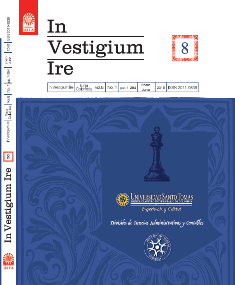IDENTIFICACIÓN DE LA INFLUENCIA DE LOS SÍMBOLOS DE PODER EN LA FORMACIÓN DE EQUIPOS AUTODIRIGIDOS. UN ESTUDIO EN QUERÉTARO
Contenido principal del artículo
Resumen
Los actuales esquemas mundiales de productividad exigen no solo que los integrantes de las organizaciones participen brindando lo mejor de sus competencias para lograr los estándares de clase mundial que el concierto empresarial exige, sino que además, se debe sumar el talento y la dedicación de todos y cada uno de sus integrantes, para ello, el desarrollar esquemas que coadyuven a la integración de sus participantes resulta indispensable.Es en este orden de ideas que resulta importante la identificación de los símbolos de poder, ya que estos símbolos pueden servir para unificar o, para dividir a los diferentes grupos sociales que integran las organizaciones. Para lograr identificar los símbolos de poder en las organizaciones seleccionadas del Estado de Querétaro se empleará un instrumento que es tanto confiable como válido para su identificación. Los resultados de esta investigación coadyuvarán en la formulación de estrategias básicas para que las empresas puedan lograr la tan anhelada productividad al tiempo que promueven el cambio de los paradigmas empresariales que existen en gran medida en la actualidad, buscando brindar herramientas para obtener equipos de trabajo autodirigidos. Esta investigación es no experimental, transeccional, descriptiva empleando una muestra de sujetos tipo de 130 empresas.
Detalles del artículo
Cómo citar
Mejía-López, D. Y. (2016). IDENTIFICACIÓN DE LA INFLUENCIA DE LOS SÍMBOLOS DE PODER EN LA FORMACIÓN DE EQUIPOS AUTODIRIGIDOS. UN ESTUDIO EN QUERÉTARO. In Vestigium Ire, 8(1), 112-123. Recuperado a partir de http://revistas.ustatunja.edu.co/index.php/ivestigium/article/view/1005
Número
Sección
In Vestigium Ire Vol. 8
Investigium Ire de http://revistas.ustatunja.edu.co/index.php/ivestigium esta bajo una licencia Creative Commons Reconocimiento-NoComercial-SinObraDerivada 4.0 License.
Citas
McSHANE Steven L. y VON GLINOW Mary Ann, “Or¬ganizational behavior: Emerging realities for the workplace revolution”, 3ª Edición, McGraw-Hill, New York, 2005.
Garagalza, L. La Interpretación de los Símbolos. Her¬menéutica y lenguaje en la filosofía actual. Presen¬tación de A. Ortiz-Osés. Editorial Anthropos, Primera Edición; Barcelona, España. 1990.
Hernández, S. Metodología de la Investigación, Mc¬Graw Hill Interamericana. Tercera Edición. México 2003.
Hoffs, A. El Poder del Poder. Editorial Diana. Primera Edición. México.1986.
Jung, C. El hombre y sus Símbolos. Editorial Paidos Ibérica, S.A. Segunda Edición en español. España 1997.
Lussier, R. Liderazgo. México. Editorial Thomson. 2002.
Martínez, J. Símbolos de Poder en las Organizaciones y sus Repercusiones. Hitos de las Ciencias Econó¬mico- Administrativas. La Gaceta de la Universidad Juárez Autónoma de Tabasco. Villahermosa, Tabasco; México. Año 7, Número 18. Mayo-agosto 2001.
McSHANE Steven L. y VON GLINOW Mary Ann, “Or¬ganizational behavior: Emerging realities for the workplace revolution”, 3ª Edición, McGraw-Hill, New York, 2005.
Weber, M. Economía y sociedad. Fondo de cultura económica. 12ª reimpresión. México. 1998.
Garagalza, L. La Interpretación de los Símbolos. Her¬menéutica y lenguaje en la filosofía actual. Presen¬tación de A. Ortiz-Osés. Editorial Anthropos, Primera Edición; Barcelona, España. 1990.
Hernández, S. Metodología de la Investigación, Mc¬Graw Hill Interamericana. Tercera Edición. México 2003.
Hoffs, A. El Poder del Poder. Editorial Diana. Primera Edición. México.1986.
Jung, C. El hombre y sus Símbolos. Editorial Paidos Ibérica, S.A. Segunda Edición en español. España 1997.
Lussier, R. Liderazgo. México. Editorial Thomson. 2002.
Martínez, J. Símbolos de Poder en las Organizaciones y sus Repercusiones. Hitos de las Ciencias Econó¬mico- Administrativas. La Gaceta de la Universidad Juárez Autónoma de Tabasco. Villahermosa, Tabasco; México. Año 7, Número 18. Mayo-agosto 2001.
McSHANE Steven L. y VON GLINOW Mary Ann, “Or¬ganizational behavior: Emerging realities for the workplace revolution”, 3ª Edición, McGraw-Hill, New York, 2005.
Weber, M. Economía y sociedad. Fondo de cultura económica. 12ª reimpresión. México. 1998.


